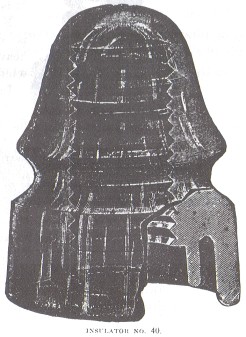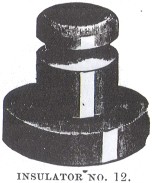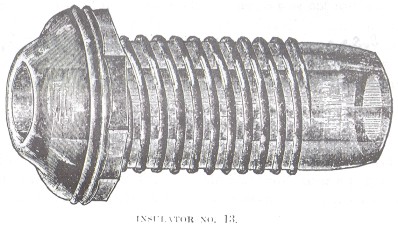The Mystery of S.S. & Co. MFG.
by Bob Stahr
Reprinted from "Crown Jewels of the Wire", December 1993, page 7
I got home from work one evening and the message light on my answering
machine was blinking. It was Elton Gish asking me if! would find a few trade
journal articles for him. I wrote down the information, then I called the Purdue
University Library. I asked a librarian to check the computers there to see if
they had any of the trade journals I was looking for. They had three of the
five.
On a previous visit to Purdue, I looked through a few journals to see what
I could find. I had only scratched the surface and there were quite a few more
books to look through. I decided that it would be worth the hour and half drive
to get copies for Elton and to look through some more issues I hadn't seen. I
had found four American Insulator ads (see CJ Nov. 93) and a few ads showing
Chicago insulator on the first trip. I thought those ads were very promising.
Who knows what I might find next!
All of the journals I wanted to look at
would most certainly be in the library's storage department. The storage
department is closed on Saturdays, open during the week, and open from 1 to 5 on
Sundays. I made plans to go there on a Sunday.

I was up early Sunday
anticipating finding some good information. I left my house at 9:00 a.m. and got
to the school by 10:30. The regular library didn't open until 11:00 a.m., so
that gave me time to sit down and review my notes. As soon as the library
opened, I grabbed the first available computer and looked up as many journals
and their call numbers as possible. Having the call number and which volumes
they owned, would enable me to get them from storage faster. I had that task done by 12:30. That gave me enough time
to grab something for lunch and get back by 1:00 when the storage department
opened.
I looked for Elton's articles first and made copies of them. I then
looked through a few journals I hadn't seen before. These early issues were not
indexed, so I had to scan the books for interesting drawings. In the first one,
I ran across an article on the Bain Insulator. I'd seen this same article
before, so it wasn't something I needed to copy.
The second volume I looked
through still seems like a dream to me. While leafing through Electrical
Industries, Vol. 1 No.2, 1890, I saw a drawing of a CD 160 or CD 162 fly by. I
turned back a few pages and red the caption below. Insulator No. 40, I thought
to myself, "Could this be the S.S. & Co. insulator?" I started to
read the text about it. "...brought out by Messrs. Shay, Stephens &
Co., Chicago." I couldn't believe my eyes! I found the name behind the
unknown S. S. & Co. embossed insulators.
|
Improvements in Insulators.
The three accompanying cuts illustrate some improvements in insulators
recently brought out. by Messrs. Shay, Stephens & Co., Chicago.
Insulator
No. 12, made of porcelain, is for " high insulation." It is soon
to be produced in glass.
No.13 is a floor insulator, and is used extensively for running heavy wires
through floors and window
frames.
Insulator No. 40 is a "double petticoat" of medium size, and finds a large scale.

Other popular insulators, besides those shown in the illustrations, are
designated by the manufacturers as Nos. 2, 8, 19 and 27. No.2, the "pony double
petticoat" insulator, is for the smallest wire in use. No.8 insulator,
which has a deep groove, is suitable for the largest size wire used. Their No.
19 double petticoat deep-grooved insulator is suitable for large or small wire, and will, they claim, "stand
the highest potential without the slightest leak."
Insulator No. 27 is made of porcelain and glazed entirely. The same size and shape
insulator is henceforth to be made of glass.
|
I had been wanting to find out who S.S. & Co. was for a couple of years.
I had talked to both N.R. "Woody" Woodward and Joe Maurath, Jr. to
find out how extensive their research was on S.S. & Co. Woody _had searched
Chicago City directories, found a name that fit, and researched it until he came
to a dead end. Joe said essentially the same thing. It sounded like I'd be
involved in a long search, if there was even an answer to be found, And now, in
this one journal it just popped out when I wasn't even looking for it!
Reading the text reprinted within this article, you'll notice they mention
the No. 40 and the No. 19, but they also mention the numbers 2, 8 and 27. The
number 2 sounds strange in that it's a double petticoat PONY. Many old catalogs
listed the CD 160 as a double petticoat pony. The text describes the No. 40 as a
"double petticoat" of medium size, instead of a double petticoat pony.
The number 8's description says that it is suitable for the largest size wire
used. This description is rather vague. Assuming the No. 27 is also a pintype, I
would guess that the porcelain piece mentioned is probably a beehive because it
will also be available in glass. This is a very early date for pintype porcelain
and could very well be a Thomas or more likely a Pass and Seymour product. There
is a slight possibility that the descriptions got mixed up when the article was
written, but it's more likely that these other styles were never made. There is
always a possibility one of them may turn up, so keep your eyes open.
It's also
interesting to note that they show a floor insulator. I've seen similar ones in
catalogs depicting Hemingray items. It's likely that the floor insulator, the CD
160 and the CD 162 units were all made by Hemingray. Hemingray was probably
already making CD 160's and CD 162's by this time, so making another mold
embossed S.S. & Co. wouldn't be difficult.

By studying the S.S. & Co. CD 160 and CD 162, I've noticed molding and
thread forming methods that seem identical with the H.G. CO. PETTICOAT's. The
embossing on the CD 160 is S.S.& Co. MFG'S over CHICAGO over No 40 on the
front. On the rear it says DOUBLE over PETTICOAT. There is also a CD 160
embossed H.G. CO. over No 40 on the front, and DOUBLE over PETTICOAT on the
back. The H.G.CO. appears to be embossed over something blotted out. Note the
location of the embossing compared to the S.S. & Co.'s in the picture below.
Since S. S. & CO. didn't seem to last long, (as evidenced by the lack of
insulators) Hemingray probably relettered the old S. S. & Co. molds with the
H.G. CO. embossing and neglected to remove No 40 and the word DOUBLE.
With the information I uncovered, I took a trip to the Chicago Historical
Society to find out if they had any more. I called my friend and fellow
researcher, Rick Soller, to see if he would like to go to look through any
information they might have on file. He said he would love to see what we could
dig up.
It was a perfect day to be inside. It was the day before Halloween and
it was snowing! Rick looked up several things there: Electrical Supply Co.,
Foree Bain, and some old electrical catalogs. I looked through several city
directories to find out how long S. S. & Co. was around and then helped Rick
when I was finished. I found out a bit more that completes the story.
The
directories consisted of two main parts. The first part was an alphabetized
listing of people followed by the name of the company that they might have been
associated with. Some entries just listed people as laborers or milkmen with no
mention of company. The second section consisted of a listing of businesses
according to what they sold. You might say they were the "yellow
pages". I looked under the alphabetized section first, and when I found out
what they sold, I went to the business section. Some entries in the business
section included lawyers, lumber and machinery.
In 1887 and 1888, there is no
listing for a Mr. Shay, but there was a Charles H. Stephens listed. Mr. Stephens
was listed at W. Jackson and the N.W. corner of Clinton. His name was followed
by the word "glass". I was not sure whether this meant he was a
glassworker or sold glassware at that address. Looking in the business section,
Mr. Stephen's name was listed under "glass." His home address was
listed as 702 Warren Avenue.
In 1889, a Mr. H.J. Shay was listed, followed by
the name of Shay, Stephens and Co. located at 134 VanBuren Avenue. His home
address was also given as 702 Warren Avenue. When looking up Mr. Stephens' name,
it was followed by the word "glassware". There is not mention of Shay,
Stephens and Co. I'm not sure why his name was not followed by his association
with S. S. & Co. He may have just listed himself separately on purpose.
There's also a second listing that says he was a broker. Looking up
"glass" in the business section of the directory, Mr. Stephens' name
was found under "glass (window and plate)", but again there is no
mention of Shay, Stephens and Co.
In 1890 Shay, Stephens and Co. was again
listed at 134 VanBuren Avenue. This time the officers listed were H. J. Shay,
Charles H. Stephens and M.D. Stephens. All of them were residing at 702 Warren
Avenue. In the business section of the directory, Mr. Stephens' name was again
listed under "glass (window and plate)", but no mention of his
association with S. S. & Co. If anyone looked in the glass section they
would not find S. & S. Co. but they would find Mr. Stephens' name.
In 1891 there is no listing for S. S. & Co. Henry J. Shay was listed as
a clerk at 594 W. Madison and Charles Stephens was listed as a manager at 56 S.
Canal Street. Both of them were still residing at 702 Warren Avenue.
Finally,
in 1892, Shay was not listed in the directory at all and Charles Stephens'
occupation was listed as selling bicycles at 1403 W. 12th Street, his home
address still at 702 Warren Avenue.
With this new information, we know that S.
S. &Co. probably lasted from 1889-1890 proving it was a short lived
operation. I'm not sure how many insulators out there are embossed with S. S.
& Co., but there can't be very many. The way that S. S. & Co. was listed
seems strange. The only way to find it in the directory is if you knew the name.
If S. S. and Co. made glass, I think they would have been listed in the business
section under glass. Instead Mr. Stephens' name was listed alone. In 1889, Mr.
Stephens also listed himself as a broker. I think he was a glass broker,
distributing glass made by others, probably glass made by Hemingray.
Any more
comments on this article would be greatly appreciated. I hope to be able to
check some more Chicago records to see if I can locate any more information.
Thanks to Bill and Jill Meier for bringing the CD 160 H.G.CO. to the London show
so I could do a closer inspection.
|
